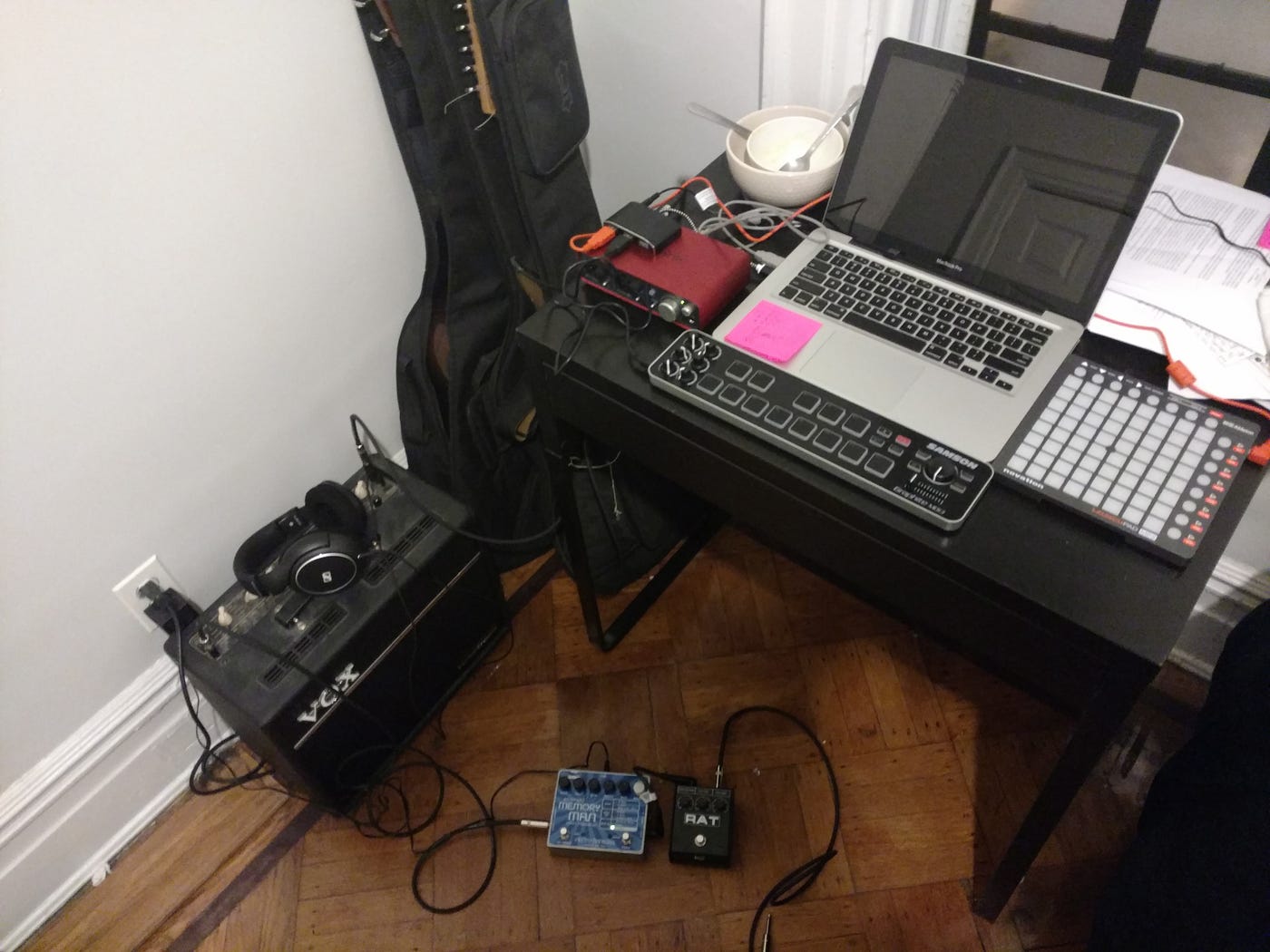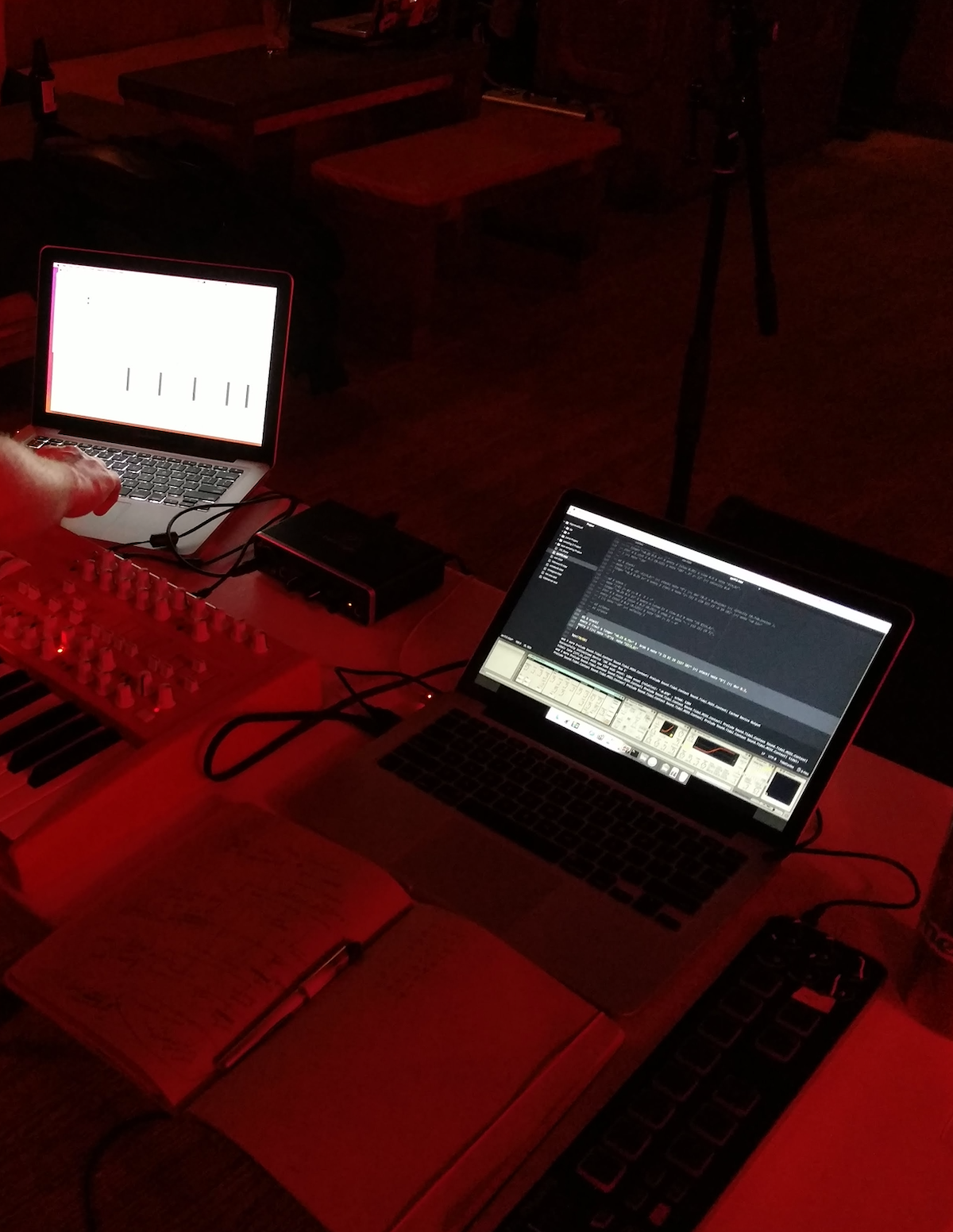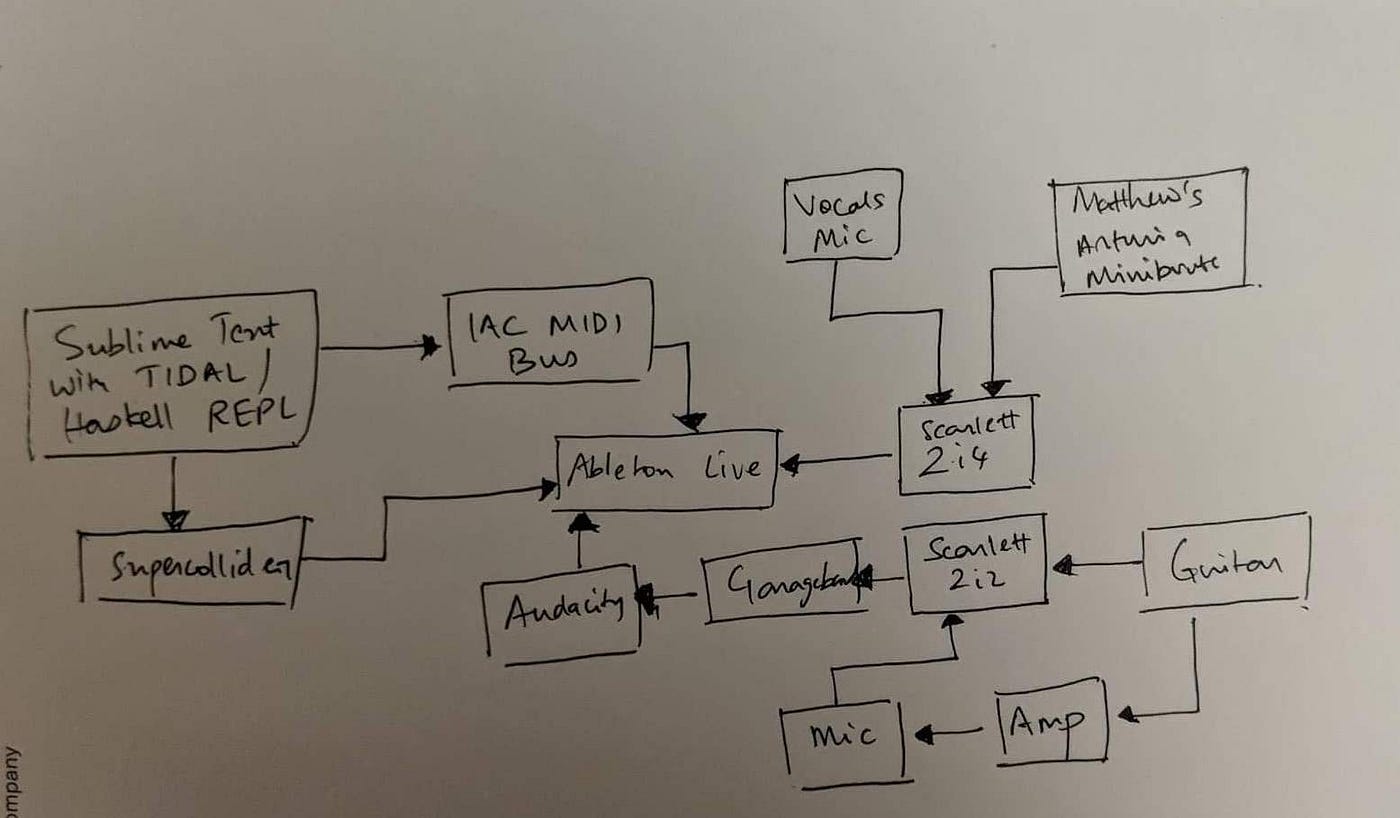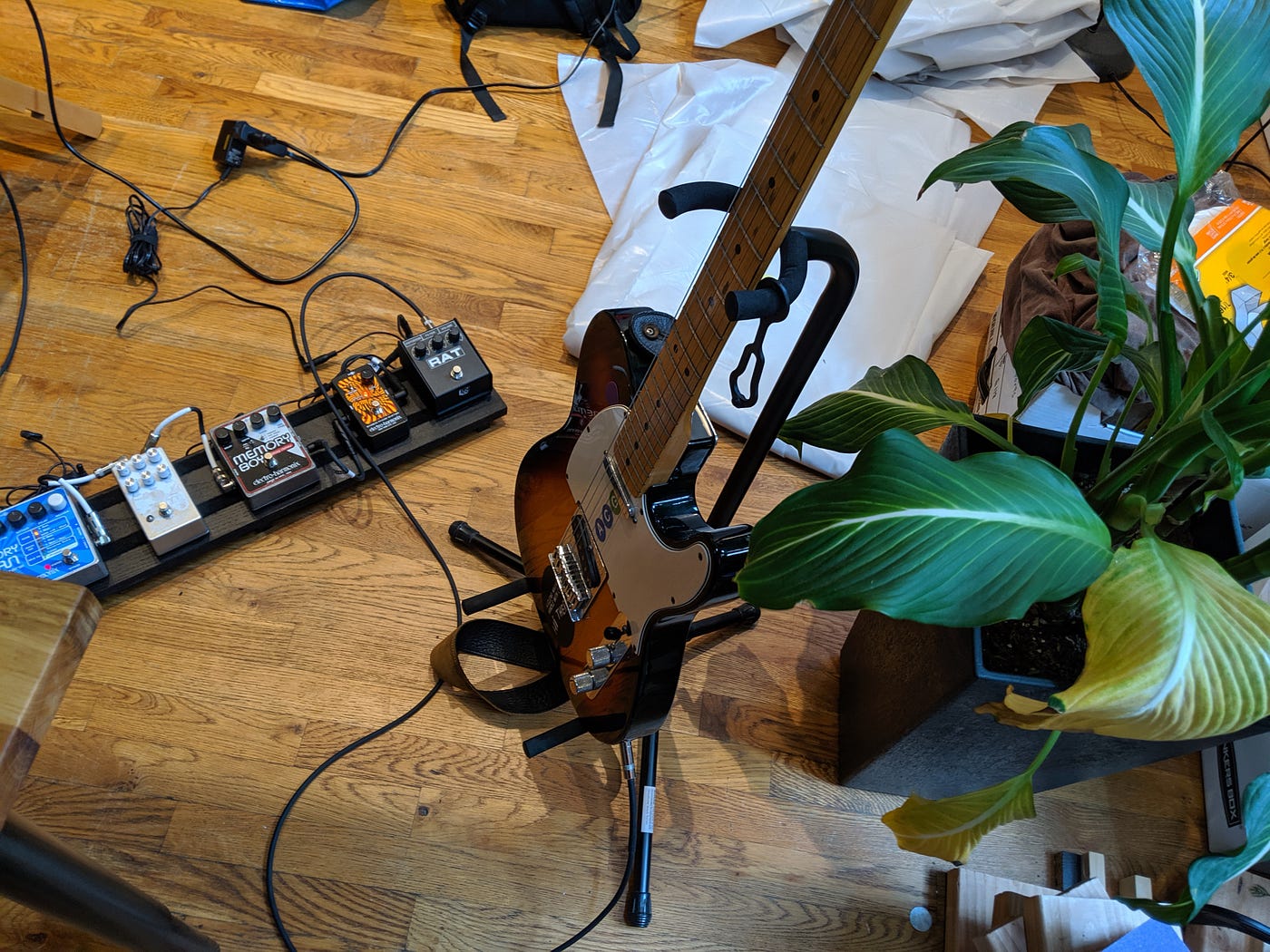Chronicles of the Reckoner Gearspace
Posted Oct 31, 2020
Tags: music, gear, production
Usually, upon discovering that I’m a musician, people ask me what kind of music I make. Always a moment of stammering followed by me getting flustered as I mentally put together an answer that best suits the context. It usually involves stringing together broken phrases like “oh, I use Ableton Live…play my guitar…live code sometimes”
This blog post is the long answer to that question. The goal here is not to show my gear off (though I’m proud of all the thrifting), but to present the evolution of my setup over time, the impetuses behind each change correlated with the music I’ve made with them.
A lot of the inspiration for putting this self-indulgent account together comes from a recent tweet from @vgr about organizing his junkspace full of cables, adapters, power tools etc., and The King Of Gear, a crowd-sourced account on every piece of equipment one of my favorite bands has ever mentioned or been seen with.
I will gloss over everything from 2008 to 2013, which mainly involved fiddling with free DAWs, found samples, rudimentary synth plugins and recording the occasional guitar cover. During this time, I acquired a used Mexican Telecaster, and Roland Cube 15XL — a cheap solid state practice amp with an overdrive circuit.
2013–2014
Octaves: I was briefly part of a college band called Octaves. We mostly played prog-rock rearrangements of carnatic compositions, and snuck in the occasional Bollywood cover to pack shows. My guitar signal chain was incredibly simple at the time:
- Telecaster >> Digitech RP90 >> Roland Cube 15XL
I only had the guitar and the amp, and borrowed the band’s effects processor during my time with them. I didn’t need much beyond overdrive and the occasional phaser, so this was good enough.
Anachronism EP: A lot of the setup for my debut EP Anachronism materialized a few months prior, when I recorded music for a video game called Exist. This was around the time I got my first pedal — a used EHX Memory Boy. I experimented with a couple of different signal flows for my guitar at the time.
- Telecaster >> Memory Boy >> Roland Cube 15XL >> MacBook Pro 2012 webcam mic >> GaragebandThe noisy modulated delay from this setup is audible in Desire
- Telecaster >> Garageband (Effects + Amp)Used for the ambient flourishes in Resistance
2014–2015
I spent most of this time living in a small room in Delhi, which I shared with 2 other people. Having an elaborate recording setup was impossible, so I relied almost entirely on my laptop to make music — similar to what I’d done during 2008–2013, but better. Kangaroo Communique/The Wanderer was written with this setup.
Having fully squeezed Garageband in making Anachronism, I transitioned to using Ableton Live. I was partially inspired by Bangalore acts like Sulk Station; their setup consisted of MIDI controllers feeding into Ableton sessions. Around this time, I acquired a Samson Graphite MD13 and a Novation Launchpad Mini to play with Ableton.
2015–2016
I moved to NYC in the fall of 2015 and, among other belongings, abandoned the Roland amp in the process. I replaced it with a Vox VT20+ acquired off craigslist. This has been my amp since. I also briefly had access to a friend’s Roland TR727 hacked to play 707 sounds. TR727>>Memory Boy was my gear of choice for shows with local noise music ensembles
Fracking: Most of Fracking was recorded with a relatively simple setup, and was a culmination of all the exploring I had done with Ableton Live the year before. I did, however, acquire an audio interface and record some guitar parts with that.
- Telecaster >> Memory Boy >> Focusrite Scarlett 2i2 >> Ableton LiveAudible on Sprpklsm, Eight Days.. and Kindred.
2017
Source Festival setup: Source Festival was the first time I’d performed in any capacity since leaving Octaves in 2014. It was a steep learning curve with the new setup and a litmus test of whether or not the repertoire I’d developed with my gear will hold me up on stage (they did). Around this time I acquired more used pedals — an EHX Memory Man and ProCo Rat 2. I briefly put Memory Boy away, leaning towards digital delay.
- Telecaster >> ProCo Rat 2 >> Memory Man >> Vox VT20+
- Launchpad Mini + Samson Graphite MD13 >> Ableton Live

Setup from rehearsals before Source Festival, May 2017. I ended up not using MD13 for the show.
Towards the end of that year, I got deliberate about gathering equipment for a home studio. I got into live coding and spent more time sampling sounds to trigger with TidalCycles. By late 2017, I had made early recordings for Instructions Unclear. I had come around to liking the noisy textures from Memory Boy once again, and bought another used analog delay pedal — an Earthquaker Space Reverb. Not wanting to open the can of worms that is amp mic’ing, I chose to rely on Garageband’s amp models. My setup started to look a bit like so:
- Telecaster >> ProCo Rat 2 >> Memory Boy >> Memory Man >> Space Reverb >> Focusrite 2i2 >> Garageband
- TidalCycles >> MIDI >> Ableton Live
- Rode NT1 >> Focusrite 2i2 >> Ableton Live
- Novation KeyStation49 >> Ableton Live
2018
Reckoner+=Matthew: Early Reckoner+=Matthew setup was small. I took nothing but my laptop on stage and ran TidalCycles. I briefly explored TidalMIDI — controlling Ableton synth parameters using my MD13, while triggering the notes via TidalCycles. I gave up after it fell apart mid-set.

The short-lived Tidal MIDI + Ableton Live setup, circa June 2018
Instructions Unclear: My home studio setup grew more and more elaborate as I made progress with the album. The setup sprawled all across my room and was frequently an inhospitable, tangled mess of hardware and software. By this point, @anirudhlpai’s Fender acoustic was mine to keep, so that had joined the fray as well.

Signal flow plans for the early sessions recording Instructions Unclear, circa March 2018
2019
I spent the first half of the year recording Instructions Unclear, for which the setup stayed mostly the same, besides the addition of an EHX Small Stone phasor (the only pedal that I own that isn’t used). By this time, I started mic’ing my amp with the Rode mic in order to capture as much of the tube grit as I could. Audible in Winter Fingers and the second half of Placards.
Reckoner+=Matthew early 2019 shows: With more of Instructions Unclear materializing by early 2019, I began testing some of these songs live. The earliest of these began with
- TidalCycles
- Telecaster >> Space Reverb >> Memory Man >> VT 20+
At some point in 2019, I figured it was more efficient for me to carry a pedalboard as opposed to a tote bag full of pedals and adapters. My guitar signal flow solidified as well, with the only addition being a tuner pedal in late 2019.

Reckoner+=Matthew live setup, circa June 2019
2020
Initial considerations for 2020 was to optimize my live rig to play as many shows as possible; possibly even tour. Thanks to the pandemic, however, I ended up focusing more optimizing for rehearsals and recording instead. I got a Mackie ProFX12v2 and a used MicroKorg. While the Mackie doesn’t provide multi-track outputs, its presence enabled new workflows for rehearsing and performing. The MicroKorg is about as good as most software synths, but I like having tactile external hardware that doesn’t burden my computer.
The Mackie ProFX12v2 is on the bottom right of the frame; and MicroKorg behind the tiny chair
More recently, I replaced my Fender acoustic with a smaller, concert-size Ibanez AVC9. The open pore sound is so much welcome and so is the smaller body.
It’s almost the end of 2020, and I hope to spend the remainder of it working with what I have. I’m not entirely sure where I want to go from here. I am wary of hoarding equipment and playing myself into decision fatigue when I actually sit down to make music.
After the world heals itself a little bit, I would still love to scale down and optimize for performing with a travel-friendly setup. That said, it would also be good to work on achieving a better setup at home in a way that uses space more efficiently; this might involve hacking bits of furniture. Mostly, I’m curious to see if the new setup will betray its presence in new music.
Previous
← A Spring Of Farsi